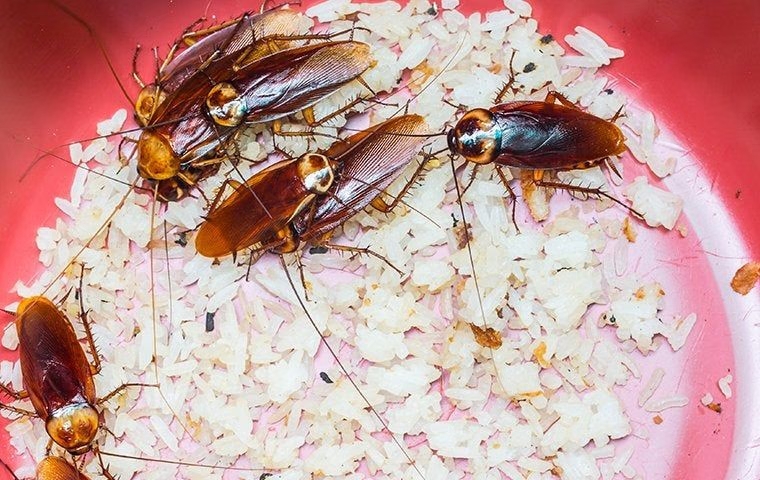
Cockroach Identification & Prevention
Cockroaches are some of the most unhygienic and difficult pests to eradicate from around your home or business; cockroach pest control is necessary to defeat these insect invaders.
Your Questions Answered: Cockroach Facts

Understanding Cockroaches: What You Need to Know
Cockroaches are well-known unsanitary insects that regularly find their way into homes and businesses in search of food. They have flat, oval-shaped bodies, a dark color that ranges from light brown to reddish-brown and black, and great skill at moving through small spaces or slipping into difficult-to-reach hiding spots.
Cockroaches are most often seen at night scavenging for food in areas like kitchens, bathrooms, and basements, as all of these areas provide a warm, humid environment within easy distance to food. The main types of cockroaches that you need to keep an eye out for around your property include American, German, and oriental cockroaches.
Are cockroaches dangerous?
A cockroach infestation may not seem like a dangerous problem at first, but these pests bring serious issues with them once they invade your property. As cockroaches scavenge for food, they spread illnesses like dysentery, salmonella, gastroenteritis, and bacteria such as E. coli. The more widespread a cockroach problem you have, the higher your chances of picking up a serious illness.
Additionally, cockroaches easily trigger allergy and asthma problems via the saliva, droppings, shed skins, and egg cases they leave around your property. A large cockroach invasion can lead to breathing problems or other allergic reactions in no time, making it incredibly important to get rid of cockroaches as fast as possible.
Why do I have a cockroach problem?
Cockroaches are one of the biggest scavenging insects out there, and they gravitate to human structures due to the food items that are abundant there. If you are dealing with a cockroach problem, it's likely because you've got food and moisture that provide sustenance for these pests, plus cracks around your property that allow cockroaches inside.
What's also problematic is that cockroaches can feed on non-food items like toothpaste, hair, and soap. Once they get into your house, they can be incredibly difficult to remove without professional assistance.
Common Hiding Spots for Cockroaches
Indoors, you will typically find cockroaches hiding around kitchens, basements, and bathrooms, where they have access to warm, humid areas, lots of moisture, and easy access to food. Outdoors, you'll likely find cockroaches gathered near piles of debris or waste disposal areas, such as trash cans and compost piles.
How do I get rid of cockroaches?
The best way to get rid of cockroaches is to invest in professional pest control in Austin provided by Aries Pest Control. Only our team of experts can help ensure the removal of every roach from your property and return it to a safe, peaceful space. Request your free inspection today to get started.
Local Roach Removal Solutions for Austin Residents
In Austin, the warm climate and vibrant lifestyle can sometimes lead to unwelcome guests like cockroaches. With the city's unique blend of urban and natural environments, these pests can easily find their way into homes and businesses, especially in areas like South Congress and East Austin, where food and moisture are abundant. Local resources, provide valuable information on pest control and sanitation practices that can help residents combat these infestations.
Many local residents face the challenge of keeping their homes free from cockroaches, particularly in older neighborhoods where structural vulnerabilities may exist. Cracks and crevices in buildings can serve as entry points for these pests, making it essential to address any potential entryways. Also, the presence of food waste in outdoor areas, such as near food trucks or local markets, can attract cockroaches, leading to infestations in nearby homes.
Understanding the local environment is crucial for effective cockroach management. The humid conditions in Austin can create ideal breeding grounds for these pests, especially during the warmer months. Residents should be proactive in maintaining cleanliness and sealing potential entry points to minimize the risk of an infestation. If you find yourself dealing with a cockroach problem, it's important to act quickly to protect your health and well-being.
For those in Austin seeking reliable roach removal, professional pest control services can provide tailored solutions to address the specific challenges faced in our area. By working with a local provider, you can ensure that your home is treated with methods that are effective and safe for your family and pets.
Flower Power Reviews
Hear from Our Satisfied Customers
-
 "Aries knows pest control."I had a serious problem a few years back. Kevin came out, set traps, returned and disposed of the critters because I was terrified, put out bait traps and sealed entrances, and I ain't seen nothing since, thank God! Thorough and responsive.- Regina G.
"Aries knows pest control."I had a serious problem a few years back. Kevin came out, set traps, returned and disposed of the critters because I was terrified, put out bait traps and sealed entrances, and I ain't seen nothing since, thank God! Thorough and responsive.- Regina G. -
 "I wholeheartedly recommend their company."Got home after a long absence and found a wasps nest in our patio. They came out the same day and took care of them and found an even bigger nest and removed it as well.- Don M.
"I wholeheartedly recommend their company."Got home after a long absence and found a wasps nest in our patio. They came out the same day and took care of them and found an even bigger nest and removed it as well.- Don M. -
 "Fast professional service that works."We have had to request occasional spot treatments for fire ants trying to return - Aries always responds quickly and at no charge - they really do honor their warranty.- David C.
"Fast professional service that works."We have had to request occasional spot treatments for fire ants trying to return - Aries always responds quickly and at no charge - they really do honor their warranty.- David C. -
 "Nothing but compliments to their team!"Shopped lots of companies in the area and these guys are the best price for their services. Always on time and give notice the day before upcoming appointments and when they are on the way. They do a good job and have fair prices.- Brandon D.
"Nothing but compliments to their team!"Shopped lots of companies in the area and these guys are the best price for their services. Always on time and give notice the day before upcoming appointments and when they are on the way. They do a good job and have fair prices.- Brandon D. -
 "Good solution for our rental properties."Fair price, no contracts, on-line billing with CC auto-pay, good customer service, work directly with tenants to schedule service (and no complaints about bugs!) - what's not to like?- Mike C.
"Good solution for our rental properties."Fair price, no contracts, on-line billing with CC auto-pay, good customer service, work directly with tenants to schedule service (and no complaints about bugs!) - what's not to like?- Mike C. -
 "Very courteous, patient, and descriptive!"\Each representative I’ve had the pleasure of working with has been very knowledgeable about the services they provide, and their response times are amazing!- Arnold W.
"Very courteous, patient, and descriptive!"\Each representative I’ve had the pleasure of working with has been very knowledgeable about the services they provide, and their response times are amazing!- Arnold W.
